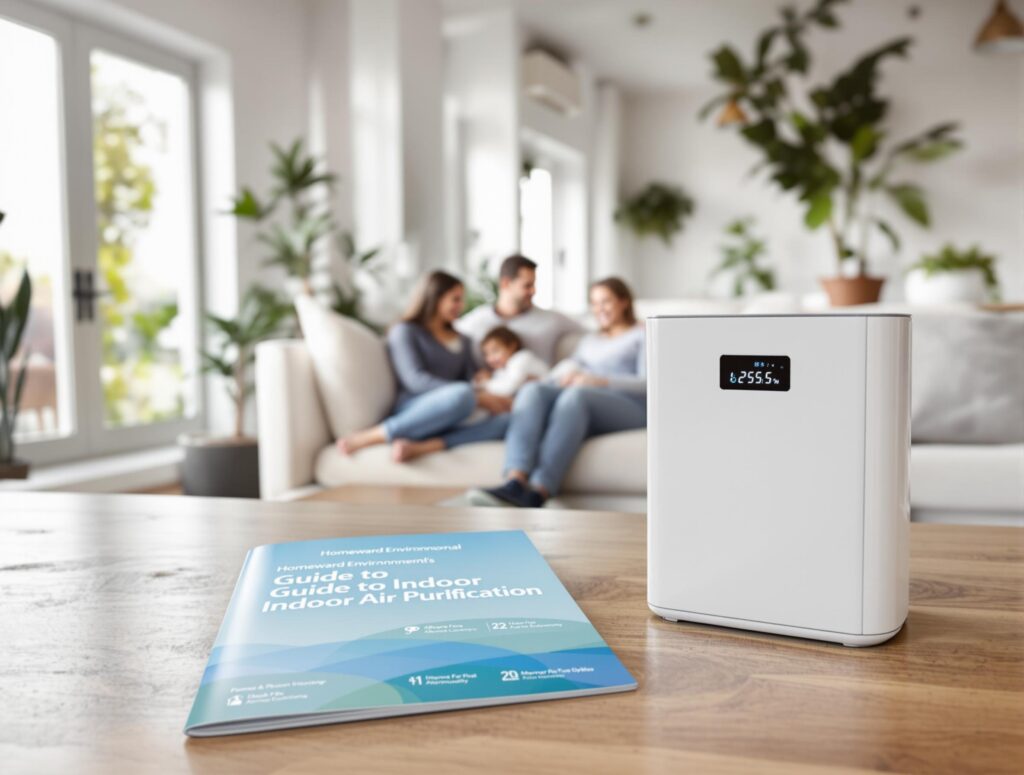Maintenance of Air Purifiers
Regular upkeep of air purifiers is absolutely vital for achieving peak performance and extending their lifespan. It’s imperative to adhere to the manufacturer’s guidelines regarding filter swaps—most filters demand a change every three to six months, influenced by how much you use them and the environment they’re in. But wait! Dust and debris love to settle on these machines, which can seriously hamper their efficiency. A simple wipe-down of the exterior and a thorough clean of any pre-filters can do wonders for maintaining airflow and ensuring your device runs smoothly.
But there’s more! Keeping an eye on how well your purifier is doing isn’t just smart—it’s essential! Many contemporary models are savvy enough to come with handy indicators that alert users when it’s time for a filter change or if maintenance is overdue. At Homeward Environmental, we encourage establishing a regular check-up routine that empowers homeowners to gauge their air purifier’s effectiveness consistently. Plus, keeping an organized log of when filters were changed or maintenance was performed helps illuminate usage patterns while also enabling you to tackle potential issues before they become big problems.

Tips for Keeping Your Air Purifier in Top Condition
For your air purifier to truly shine and operate at its peak, regular maintenance is not just important—it’s essential. Start by diving into the realm of filters; check them meticulously and replace them as per the manufacturer’s guidance. When those filters are choked with dust and allergens, they don’t just clog up airflow—they stifle the very essence of purification! Don’t stop there; give attention to those exterior surfaces and vents too. A build-up of dust can sneakily sap efficiency, drawing down performance in ways you might not even notice until it’s too late.
Now, let’s talk about keeping a close eye on your unit’s performance indicators—these little gems can be your best allies in maintaining air purity. Modern air purifiers come armed with sensors that reveal insights into both air quality and filter status. Tune into these signals! They’re your cues for action: whether it’s time to swap out a filter or tweak settings for maximum effectiveness. And while you’re at it, think proactively about minimizing particles entering your space—say goodbye to indoor smoking and cut back on harsh cleaning products. These simple adjustments can do wonders for extending not only the lifespan but also the overall functionality of your beloved air purifier!
Natural Methods for Improving Indoor Air Quality
Bringing indoor plants into your living spaces can dramatically transform the air quality, elevating it to new heights! Think about spider plants, peace lilies, and snake plants—these green warriors are celebrated for their remarkable ability to suck up nasty toxins like formaldehyde and benzene. But wait, there’s more! The lush presence of foliage does wonders beyond just cleaning the air; it nurtures our psychological well-being, weaving a delightful thread that connects us to nature right within our home.
And let’s not overlook the enchanting world of essential oils—they serve as natural air fresheners, infusing our environments with delightful aromas while steering clear of synthetic fragrances that might trigger sensitivities or allergies. It’s a win-win!
But hold on—there’s even more we can do! Natural remedies stand ready to further elevate indoor air quality through some savvy strategies. Take humidity levels: keeping them in check is vital because too much moisture invites unwanted guests like mold and dust mites. What can you do? Simple tricks abound! Use dehumidifiers or crank up exhaust fans in kitchens and bathrooms to keep those pesky problems at bay. And don’t forget the power of fresh air—a quick crack of windows lets in revitalizing breezes, even when temperatures dip.
By embracing these organic methods, we’re not just cultivating healthier living spaces—we’re nurturing overall comfort and enhancing our sense of well-being. So why not dive into this verdant journey? Your lungs (and spirit) will thank you!
Incorporating Plants and Natural Remedies
Plants, those green wonders of nature, double as our very own air purifiers—transforming indoor atmospheres with their remarkable ability to gobble up toxins and exhale invigorating oxygen. Among them, the ever-reliable snake plants, whimsical spider plants, and serene peace lilies stand out like superheroes in the battle against stealthy pollutants such as formaldehyde, benzene, and carbon monoxide. Picture this: introducing these leafy companions into your home not only spruces up the decor but also cultivates a sanctuary teeming with fresher air for everyone inside.
But wait! The magic doesn’t stop there. Enter natural remedies to supercharge this purification adventure. Essential oils—oh yes! These fragrant elixirs boast antimicrobial prowess that can vanquish airborne nasties lurking about. Imagine filling your space with a diffuser wafting delightful scents of tea tree or eucalyptus; it’s like inviting wellness itself into your home while indulging in an aromatic embrace. And let’s not forget the power of cleaning products born from nature’s bounty—free from harsh chemicals—they play their part too by reducing indoor pollution levels even further! Together, plants and essential oils weave a tapestry of health within our living quarters—a lush haven where cleaner air reigns supreme!
| Plant Name | Pollutants Removed | Care Level | Natural Remedy |
|---|---|---|---|
| Snake Plant | Formaldehyde, benzene | Low | Tea Tree Essential Oil |
| Spider Plant | Carbon monoxide, xylene | Low | Eucalyptus Essential Oil |
| Peace Lily | Ammonia, formaldehyde | Moderate | Lavender Essential Oil |
| Areca Palm | Formaldehyde, toluene | Moderate | Peppermint Essential Oil |
The Role of Ventilation
Ah, the dance of air—an intricate ballet that plays out within the confines of our indoor sanctuaries! Adequate airflow isn’t just a luxury; it’s a vital force for crafting pristine indoor air quality. Imagine proper ventilation systems as diligent sentinels, tirelessly working to banish stale air while ushering in refreshing currents that weave through our living spaces. This dynamic interplay curtails the buildup of pesky pollutants—dust motes floating like unwelcome guests, allergens lurking in shadows, and volatile organic compounds that whisper their harmful secrets over time. Breathe easy: when we ensure these spaces are well-ventilated, we bolster not only health but also elevate comfort levels to blissful heights.
Now enter the realm of natural ventilation—a simple yet powerful act! Flinging open windows and doors can transform stagnant interiors into vibrant havens when outdoor conditions play nice. And let’s not forget those trusty exhaust fans nestled in kitchens and bathrooms; they’re unsung heroes battling moisture and odors with gusto! But wait—there’s more! Like any good system worth its salt, regular maintenance is key to keep these ventilation mechanisms hummin’ along efficiently.
And if one seeks to take it up a notch? Ah yes, behold mechanical ventilation solutions! Picture energy recovery ventilators swooping in like superheroes dedicated to optimizing air exchange while slyly minimizing energy loss. It’s all about creating an atmosphere where every breath feels invigorating—a symphony composed by the perfect balance of fresh air flowing freely throughout our cherished homes.
How Proper Airflow Contributes to Health
In the intricate dance of indoor environments, the presence of adequate airflow emerges as a linchpin for cultivating a healthy living space. Picture this: good ventilation acts like an invisible conductor, orchestrating the vital exchange between stale air and the crisp embrace of fresh outdoor breezes. This dynamic interplay dramatically diminishes the buildup of indoor pollutants—think dust particles swirling in corners, allergens lurking beneath surfaces, and those sneaky volatile organic compounds (VOCs) that seem to infiltrate every nook.
But hold on; there’s more! Beyond merely banishing harmful intruders from our airspace, effective airflow steps in as a guardian against excess humidity—a prime breeding ground for mold and mildew that could wreak havoc on respiratory health. It’s not just about clarity of breath; it’s about protecting our well-being at its core.
And let us not overlook thermal comfort! When air circulates freely within these four walls, it becomes a soothing balm—dissipating heat and stabilizing temperature like nature’s own thermostat. Gone are the days when drafts send shivers down your spine or stagnant pockets of air create discomfort. Instead, we find ourselves enveloped in an atmosphere ripe with pleasantness that can spark creativity and sharpen focus.
Thus, fostering optimal airflow isn’t merely an afterthought—it should be woven into the very fabric of any strategy crafted to elevate indoor air quality to new heights. After all, breathing easy is just one part of this complex equation we call home!
Understanding Air Quality Ratings
Air quality ratings—oh, what a wealth of wisdom they hold! They unravel the mysteries surrounding the indoor environment’s health. These numbers aren’t just arbitrary; they arise from meticulous measurements of specific pollutants and compounds swirling in the air we breathe. Think about it: particulate matter (PM2.5, PM10), volatile organic compounds (VOCs), and carbon dioxide levels dance around us daily. Grasping these metrics is crucial for homeowners seeking to uncover lurking dangers that might jeopardize their well-being.
But wait! Different regions boast their own air quality indices, each a unique tapestry woven with local standards that beg to be understood by diligent homeowners. A higher numerical value? Ah, that’s usually an ominous sign—a red flag waving frantically in the face of poor air quality, demanding immediate action! By keeping a vigilant eye on these ratings—like sentinels guarding our health—we can embark on proactive quests to enhance our indoor atmosphere: opening windows for fresh breezes or deploying savvy air purifiers as if equipping ourselves for battle against unseen foes.
What the Numbers Really Mean for Your Home
Air quality ratings serve as a tangible lens through which we can gauge the purity—or contamination—of indoor air. These numerical figures, often cryptic yet revealing, quantify the presence of various pollutants: think particulate matter swirling invisibly, volatile organic compounds lurking in unsuspecting corners, and carbon dioxide quietly accumulating. For homeowners striving to cultivate a healthier haven, deciphering these numbers becomes not just important but essential.
Typically, a lower numerical value translates to better air quality—like fresh mountain breezes—but when those digits climb higher? Oh dear! That’s when intervention beckons; it may be time for enhanced ventilation or robust air purification systems to swoop in and save the day.
Yet beware! As you delve into this realm of data interpretation, it’s vital to heed the guidelines laid out by esteemed organizations. The Environmental Protection Agency (EPA), for instance, provides clearly defined thresholds that delineate between acceptable and hazardous air quality levels. Homeowners must remain vigilant in monitoring these ratings; doing so empowers them to make informed decisions about necessary adjustments within their spaces. Regular check-ins on these metrics heighten awareness of potential contaminants and pave the way for meaningful changes that nurture a safer and healthier indoor environment—a sanctuary from whatever lurks beyond those walls.
Long-term Strategies for a Healthier Home
Crafting a healthier indoor atmosphere demands an assertive stance on air quality management—think of it as embarking on an expedition rather than a mere task. A meticulously structured action plan can act as your guiding compass, steering you toward lasting enhancements in the air you breathe. Start by taking stock of your current indoor air situation; deploy air quality monitors to uncover lurking pollutants and allergens that might be hidden from view. Make it a habit to revisit this assessment regularly, recalibrating your approach in response to evolving conditions and the ever-shifting seasons.
Knowledge is key here—a vital cog in the wheel! Staying abreast of air quality standards, recognizing potential indoor contaminants, and keeping tabs on cutting-edge purification technologies are all essential pieces of this intricate puzzle.
To elevate your indoor air quality significantly, blend various purification strategies into your routine. Think about fusing mechanical solutions like high-efficiency particulate air (HEPA) filters with natural allies such as houseplants celebrated for their remarkable ability to purify the atmosphere around them. Carve out time for regular maintenance rituals—changing filters and cleaning those often-overlooked ducts—as neglecting these tasks could spell disaster for system efficacy.
Breathe life into every corner of your home by ensuring adequate ventilation while striking that delicate balance between energy efficiency and the thirst for fresh outdoor breezes. Together, these multifaceted approaches cultivate a sustainable environment that nurtures overall health and well-being—a sanctuary where each breath taken feels like a step towards vitality!
Creating an Action Plan for Improved Air Quality
Crafting a thorough action plan is vital for not just achieving but sustaining superior indoor air quality. The journey begins with pinpointing the origins of pollutants—an essential first step that homeowners must embrace. Frequent evaluations of their living spaces should become second nature, as they search for lurking threats like mold, stubborn dust bunnies, or chemical off-gassing from everyday household items. Establishing a cadence for cleaning and freshening up the air can dramatically diminish those pesky unhealthy particles floating around. This could mean scheduling regular tune-ups for air purifiers, ensuring filters are swapped out or scrubbed clean on time, and weaving in tactics like welcoming plants renowned for their ability to cleanse the atmosphere.
But wait—setting explicit goals? That’s where the magic happens! Homeowners ought to spotlight areas within their sanctuary that demand immediate attention gleaned from those all-important assessments of air quality. Investing in top-notch air purifiers and arranging routine check-ups on ventilation systems can catapult indoor air quality into new heights. Plus, it’s crucial to enlighten family members about why maintaining pristine air matters so much while championing habits that promote better breathing conditions—like cutting down on aerosol sprays or opting instead for eco-friendly cleaning alternatives. By tackling air quality head-on with intention and savvy strategies, households can cultivate a truly healthier haven to thrive in!
- Identify and seal potential sources of air leaks in the home.
- Monitor humidity levels to prevent mold growth, ideally keeping it between 30-50%.
- Create a no-shoes policy indoors to minimize dirt and allergens.
- Use exhaust fans in kitchens and bathrooms to reduce moisture and odors.
- Regularly inspect and clean HVAC systems to ensure optimal performance.
- Incorporate natural air purifiers like bamboo charcoal or salt lamps in various rooms.
- Educate all household members about harmful indoor pollutants and how to mitigate them.
Conclusion
Focusing on indoor air quality is crucial—no doubt about it—for your health and general well-being. Imagine this: a holistic strategy that blends the magic of air purifiers, the charm of natural remedies to elevate air freshness, and a splash of proper ventilation can transform your living space into a sanctuary.
But here’s where it gets interesting! Taking those proactive measures to keep your air purification systems humming along smoothly? That’s key! And diving deep into the world of air quality ratings gives homeowners an edge—a power-up, if you will—to make savvy choices for their indoor havens. By weaving these tactics together, you’re not just chasing fleeting improvements; you’re paving the way for long-lasting benefits and nurturing a healthier atmosphere within your home.





